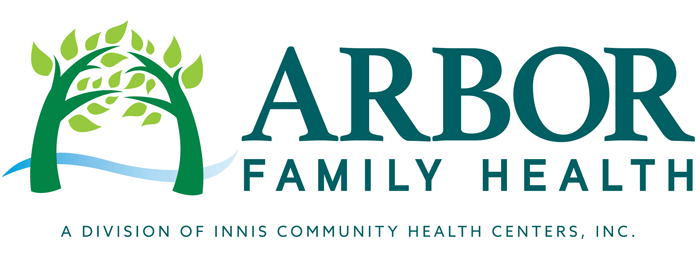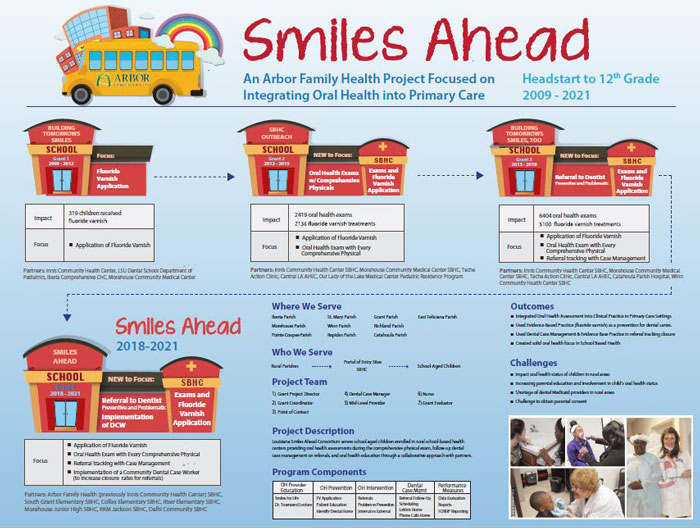School-Based Health Center Dental Outreach
- Need: To improve the oral health status of children ages 3 to 17 living in rural areas of Louisiana.
- Intervention: School-based nurse practitioners perform oral health assessments, apply fluoride varnishes when indicated, and make dental referrals, with completion rates of the latter tracked by dental case managers.
- Results: Significant numbers of school children are receiving oral health examinations, fluoride varnish applications, and receiving care coordination to improve numbers of completed dental appointments.
Evidence-level
Promising (About evidence-level criteria)Description
According to a 2016 Morbidity and Mortality Weekly Report (MMWR), tooth decay is noted as "one of the greatest unmet treatment needs among children. Pain and suffering associated with untreated dental disease can lead to problems with eating, speaking, and learning."
A 2011 Pew Center report reviewing children's dental health noted that Louisiana was found to have untreated tooth decay in 40% of 3rd graders and received a "D" after analysis of 8 dental-specific policy indicators.
To specifically address tooth decay issues, the MMWR report noted "increasing sealant use prevalence could substantially reduce untreated decay, associated problems, and dental treatment costs. The 2021 recommendations of the U.S. Preventive Services Task Force are that "application of fluoride varnish to the primary teeth of all infants and children starting at the age of primary tooth eruption in primary care practices."
Louisiana's Innis Community Health Center, Inc. — with a recent name change to Arbor Family Health — is positioned to address the oral health disparities of school children in Pointe Coupee, Avoyelles, Iberville, Morehouse, Richland East Feliciana and Grant parishes. With start-up federal grant funding, Arbor Family Health has formulated a network of 4 other Federally Qualified Health Centers (FQHCs) who are participating partners in an oral health initiative. The children's portal of access is through school-based health centers (SBHCs). These school-based health systems are able to deliver primary medical and behavioral care in their communities, but are also providing primary dental care and becoming the dental home for the students. They collaborate with the area's dental providers. However, this is often a challenge since the area has a shortage of dental providers.
Advanced nurse practitioners who serve the primary care SBHCs received additional training to perform focused oral health assessments during comprehensive physicals. When indicated, they apply fluoride varnishes. They make referrals to dental partners when treatment interventions are needed.
Funding through several Rural Health Care Services Outreach Grants from the Federal Office of Rural Health Policy (FORHP) has supported Innis/Arbor Family Health in its effort to integrate oral health into a primary care setting.
Early in 2012-2015 grant period, the primary providers discovered dental referrals were not getting tracked to completion. This concern prompted the addition of dental case management. Case management, as described by the Case Management Society of America, provides care coordination that, specific to this concern, helps navigate barriers to completing dental care appointments. Support for this work came from the 2015-2018 FORHP outreach grant.

Services offered
The oral health outreach activities conducted to date:
- Oral health assessment training of primary care providers working in the SBHC primary care settings.
- Integration of oral health exams within the comprehensive physical exam.
- Application of fluoride varnish as an evidence-based preventive practice.
- Oral health education for children in order to influence overall oral health status.
- Dental case management initiated on all referrals which were specifically classified as a preventive referral for routine preventive cleanings or problematic referrals for treatment interventions.
- Identification of the SBHC dental case manager, a non-licensed SBHC employee, to track the referral to completion or increase efforts to get the student seen by a dental provider.
- Dental case managers identify barriers to getting the child seen for the referral to a dental provider and classifies them as transportation, low family parental involvement, or lack of identified dental home provider.
- Dental referral tracking completion rate is measured
as a performance indicator for the SBHC and targets are
established for completion rates for each center.
- The referral tracking statistic becomes a quality measure for the program and is unique to each center.
- Baseline trend is established and the % of increase is then set as the target for that performing school year.
- Electronic health record data makes the referral tracking for oral health assessments, fluoride varnish applications, and treatment referrals possible in a more effective method.
Results
2012-2015 Outreach Grant Cycle results:
- SBHC providers were trained in oral health
assessments and fluoride varnish applications.
- Initial assessment of SBHC capacity for oral health exams in advance of the 2012-2015 grant goal anticipated that 1,250, or nearly 41% of the target population would need fluoride varnish applications.
- The actual number of applications exceed that initial estimate by nearly 900, or 171% of the target goal.
- In a similar light, oral health caries risk assessments totaled 2,273, or 182% of the original target estimates.
Despite these successes, only 14% of those provided with a dental referral went on to complete that referral and establish a dental home. This result prompted the decision to initiate dental case management, implemented with the support of the 2015-2018 grant.
2015-2018 Outreach Grant Cycle results:
- 100% of providers now trained in oral health assessments/fluoride varnish application through the American Academy of Pediatrics program Protecting All Children's Teeth
- 6403 completed oral health assessments
- 5100 applications of fluoride varnish
- 2350 dental referrals, averaging a 64% completion rate, substantially above the baseline 14% prior to dental case management implementation
Dental case management has now emerged as key to the SBHC's oral health assessment program success, leading to an increased number of students who ultimately are seen by dental providers.
Over the grant cycle intervals, students, parents, and school faculty have come to realize that oral health assessments are just as critical as vision and hearing assessments and an impact overall health and learning ability.
For more information on this program:
The School-based Dental Center Dental Outreach is also featured in the Oral Health Toolkit Program Clearinghouse.
Challenges
Engagement of dental colleagues was an initial challenge largely due to the low numbers of dental professionals in the area.
Replication
Because training primary care providers in basic oral health assessment and fluoride varnish application is achievable, the program is replicable in SBHCs and primary care facilities anywhere state laws allow the intervention. Referral follow-up is the key component that impacts the child's overall oral health status.
Some important strategies for success are:
- Use electronic health record data-tracking for monitoring of follow-up
- Laws vary across states regarding professionals allowed to apply fluoride varnish
- Oral health assessments integrated into the periodic comprehensive physical exam can generate revenue as a provider visit within the school-based health system
- Fluoride varnish is an inexpensive preventive evidence-based practice
- SBHC dental case management should be sustainable since these centers already provide referral tracking on other type of referrals on children seen in the centers.
- Collaboration between school systems and organizations providing SBHCs can positively impact future grant proposals and projects
Contact Information
Linda Matessino, RN, MPH, Grants Project DirectorArbor Family Health
225.921.5196
linda@arborfamilyhealth.org
Topics
Children and youth
· Delta Region
· Federally Qualified Health Centers
· Oral health
· Schools
· Wellness, health promotion, and disease prevention
States served
Louisiana
Date added
November 13, 2015
Suggested citation: Rural Health Information Hub, 2020 . School-Based Health Center Dental Outreach [online]. Rural Health Information Hub. Available at: https://www.ruralhealthinfo.org/project-examples/861 [Accessed 7 January 2026]
Please contact the models and innovations contact directly for the most complete and current information about this program. Summaries of models and innovations are provided by RHIhub for your convenience. The programs described are not endorsed by RHIhub or by the Federal Office of Rural Health Policy. Each rural community should consider whether a particular project or approach is a good match for their community’s needs and capacity. While it is sometimes possible to adapt program components to match your resources, keep in mind that changes to the program design may impact results.

